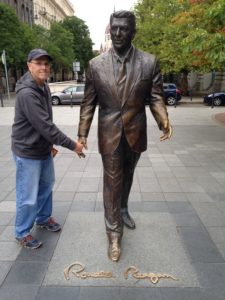I was in Budapest for a few days, in March of 1990, to cover the U.S. national soccer team in a pre-World Cup friendly loss, 2-0, to Hungary.
(A few days later I covered the Yanks in East Berlin; East Germany won 3-0.)
So this was all just the other day.
Back then, Hungary already was sidling away from the Soviet Union’s eastern European gulag and the Warsaw Pact, and the Berlin Wall had come down in Germany the previous year.
The Cold War was ending as the Soviet side of the confrontation fell to pieces. The USSR itself went to pieces in 1991.
Even those of us who were already adults when all this happened sometimes can forget, a bit, just how momentous this all was.
Which is where the statue of Ronald Reagan comes in, here in Budapest, capital of Hungary.
Reagan was president of the United States from January of 1981 to January of 1989, and he was known for his anti-communism and opposition to the heavy-handed Soviet domination of its eastern European satellites. Things were in motion, when I made my first trip to that part of the Europe.
In a speech at the Berlin Wall in 1987, Reagan called on Soviet leader Mikhail Gorbachev to order the removal of the obstruction between the two halves of the former capital, which kept Germans from moving from one side to another. A wall which had long since become the most prominent system of a forcibly divided Europe.
Speaking from a podium in front of the wall, Reagan said, in part:
“We welcome change and openness; for we believe that freedom and security go together, that the advance of human liberty can only strengthen the cause of world peace.
“There is one sign the Soviets can make that would be unmistakable, that would advance dramatically the cause of freedom and peace.
“General Secretary Gorbachev, if you seek peace, if you seek prosperity for the Soviet Union and Eastern Europe, if you seek liberalization, come here to this gate. Mr. Gorbachev, open this gate. Mr. Gorbachev, tear down this wall.”
Barely two years later, the wall came down, more from the internal collapse of the Soviet edifice than any call from a U.S. president, but some people, in Hungary, anyway, recall Reagan’s speech and his actions, and decided he should get a statue in what is called Freedom Square in Budapest.
I had no idea the statue existed till I saw it on a map of the city, pretty much in a direction I was heading while walking through some of the governmental and business areas of the country.
So we changed course a little, and there was the Great Communicator, looking younger than he did as president, greater than life-size, facing toward the American embassy but also toward a garish hunk of bronze showing the Red (Soviet) Army shooting its way into Budapest in 1945, as one monstrous regime (the Soviet Union) replaced another (Nazi Germany).
I have never had an opportunity to shake the hand of a president, and it struck me this was a chance to do so, even if this president was a 7-foot hunk of bronze, far from home.
But, at least, this is a president who is remembered fondly in several parts of the world, and particularly in eastern Europe, where honors like street names and statues are not uncommon.
I suppose I look like a child who has aged prematurely, in the photo (above). But it seemed like something to do, one Yank to another, at the moment.
Not many statues of U.S. presidents stand on foreign territory. Hungary thought Ronald Reagan deserved one.


0 responses so far ↓
There are no comments yet...Kick things off by filling out the form below.
Leave a Comment